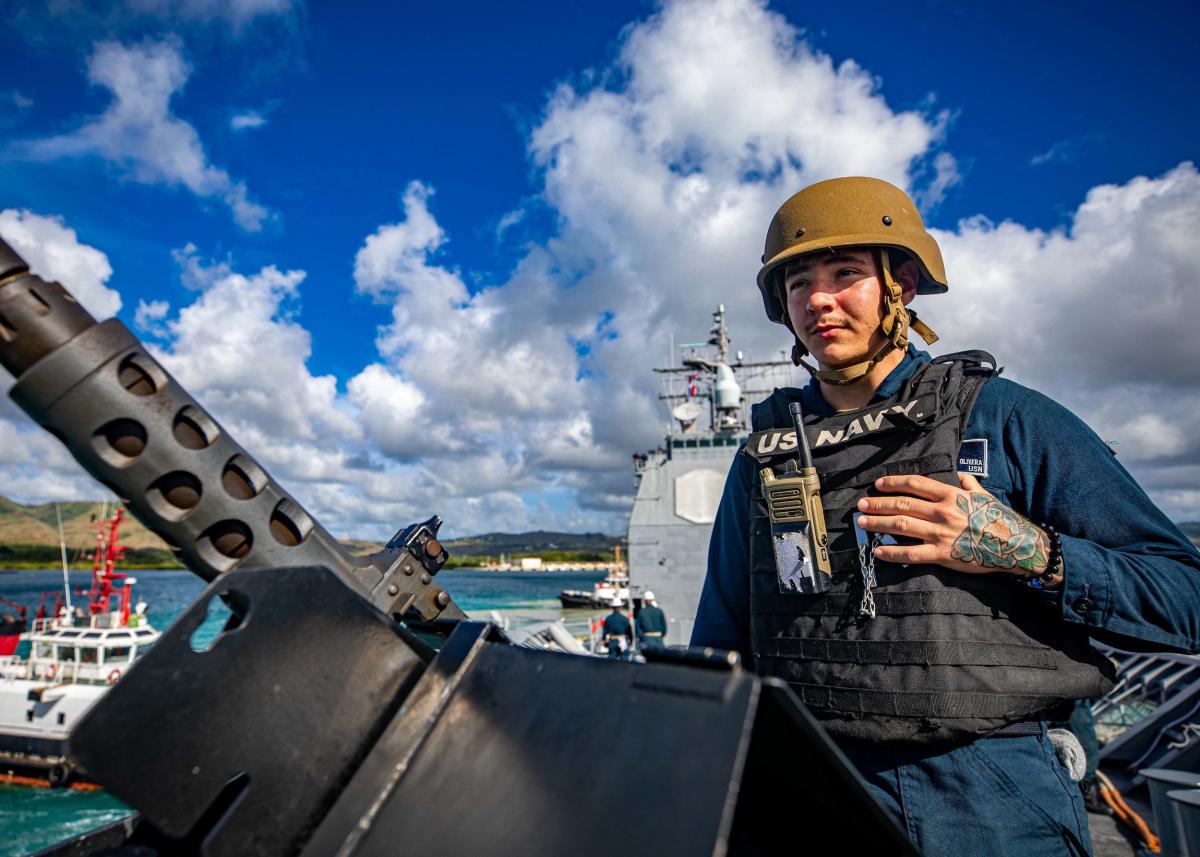No region is more important to today’s great power competition than the Indo-Pacific. For more than two decades, while the United States was rightly consumed with wars in the Middle East, China and Russia have expanded their military capabilities significantly throughout the region. Today, the People’s Liberation Army Navy (PLAN) greatly outnumbers the U.S. Seventh Fleet in the western Pacific and the U.S. Indo-Pacific Command (IndoPaCom) is focused on how best to position the forces it has against China.
The Pentagon’s Pacific Deterrence Initiative (PDI) in the fiscal year 2023 budget responds to congressional legislation to invest more in Pacific security. This essay examines the proposals within the PDI and how they address IndoPacom’s priorities, evolving Chinese military capabilities, and the importance of U.S. deterrence in the region.
IndoPacom’s Priority—Guam
The PDI directly addresses the immediate security concerns in the Indo-Pacific. The PDI is “focused on boosting missile defense, intelligence, surveillance and reconnaissance programs, infrastructure, prepositioned equipment and munitions, logistics, training, and exercises, as well as enhancing the capabilities of allies.”
Because of its strategic location, Guam is a lynchpin of U.S. military power in the Indo-Pacific. Far from the Chinese mainland, Guam is outside the range of the PLA’s short-range missiles but is still close enough to provide logistical support to U.S. forces operating in the East and South China Seas. In reviewing the organic military capability positioned on Guam, defense policy analyst Patty-Jane Geller noted that “Anderson AFB hosts F-22 fighter squadrons, as well as the Bomber Task Force, enabling significant air-based power projection from the island.” In addition, Geller stated that “the Navy has access to Guam’s deep water strategic port, which enables repair and supply of the Pacific fleet—including aircraft carriers—during a conflict with China.” As such, defending the island will preserve its vital logistical capability.
According to former IndoPaCom commander, Admiral Phil Davidson, “The most important action the Pentagon can take to increase U.S. military capability in the Pacific is to introduce a 360-degree, persistent, air and missile defense capability on Guam.” To address this primary concern, Congress appropriated $77 million for a “permanent and persistent land-based integrated air and missile defense system and associated weapon delivery system on Guam.” Admiral Davidson’s testimony clearly identifies the defense of Guam as the top priority in the Indo-Pacific. However, before Guam can serve as a springboard for military offensives, it must be adequately defended from preemptive strikes.
Despite being at the top of Indo-PaCom’s list, Guam has become increasingly threatened as Chinese advances in long-range strike capabilities are now capable of reaching the island. According to the current IndoPaCom commander, Admiral John Aquilino, China’s military buildup “may embolden [them] to unilaterally change the status quo before our forces may be able to deliver an effective response.” Admiral Aquilino’s testimony emphasizes how China desires to shift the balance of military power in the Indo-Pacific in its favor, evident in the PLA’s development of long-range strike capabilities. Furthermore, China recently released a propaganda video displaying its long-range bombers attacking Andersen Air Force Base.
The PDI’s timing is critical. In China’s arsenal are “nuclear-capable Intermediate Range Ballistic Missiles (IRBMs) and Medium Range Ballistic Missiles (MRBMs) capable of long-range precision attacks on both land and large to medium sized maritime targets . . . able to target U.S. bases in Guam and U.S. aircraft carriers operating in the Western Pacific.” Consequently, the PDI’s permanently based integrated air- and missile-defense system on Guam is more vital now than ever before. The PDI will fortify the U.S. defense posture against evolving PLA threats.
In addition to China’s advancement in long-range precision-strike weapons, the PLA has also improved its C4ISR capabilities. Recent C4ISR upgrades to China’s nuclear long-range Xian H-6K bombers have “enabled long-range nuclear precision strike missions—a capacity that since the Cold War only the [United States], Russia, and France have possessed.” This creates a crucial need for reinforced U.S. reconnaissance infrastructure to improve early detection of a possible or imminent attack. To address this potential gap in capabilities, the PDI appropriates $378,557,000 for “intelligence, surveillance, and reconnaissance (ISR) capability to enhance indications and warnings, sensor packages, [and] the development of future ISR platforms.” Through investing in future ISR platforms and missile-defense capabilities, the PDI will enable U.S. forces to deter future aggression.
In addition to defending the military assets on Guam, there is a moral imperative to advocating for the island’s defense. As a military stronghold and U.S. territory, Guam is home to “170,000 U.S. citizens . . . as well as over 20,000 American servicemembers, civilians, contractors, and their families.” Guam is a part of the U.S. homeland. As such, the defense of Guam is a matter of both homeland security and homeland defense. The PDI recognizes this moral imperative, and its implementation will best position U.S. forces to act on it.
Deterrence Matters
A permanent missile-defense system on Guam would be an effective deterrent against Chinese aggression. Missile-defense systems “convince an adversary that its attack will fail—or that the costs of overcoming missile defense systems would outweigh the benefits of success.” Establishing such a system on Guam is one way to send a message to China that the United States is adequately postured to defend its critical military stronghold in the Indo-Pacific.
Another essential component of deterring Chinese aggression is the persistent and overt display of U.S. forces working with regional allies and partners. Allied military exercises “can be designed to shape a potential adversary’s perceptions of how US and allied forces would fight. . . . Another application might be to ‘prove’ to the opponent something it already believes is true about U.S. and allied forces, plans, or strategy. Exercises designed with these secondary purposes in mind can be particularly useful for reinforcing deterrent credibility.” Persistent operations with allies and partners establish credibility and counter regional Chinese aggression and influence. The PDI increases funding for international military exercises with regional allies and partners. It authorizes $50 million to “modernize communications architecture and systems with allies and partners in the Indo-Pacific region, including exercise planning, execution, and associated equipment purchasing costs.”
Implementing the PDI is critical to preparing U.S. forces should confrontation between China and the United States escalate to war. The PDI’s proposals adequately address the IndoPaCom commander’s priorities. Most important, the PDI prioritizes a missile-defense system that sufficiently defends the U.S. territory of Guam. In today’s era of great power competition, where geopolitical tensions between the U.S. and China are at a constant flashpoint, the PDI solidifies the Indo-Pacom area of responsibility as the priority theater of operations for the foreseeable future.






